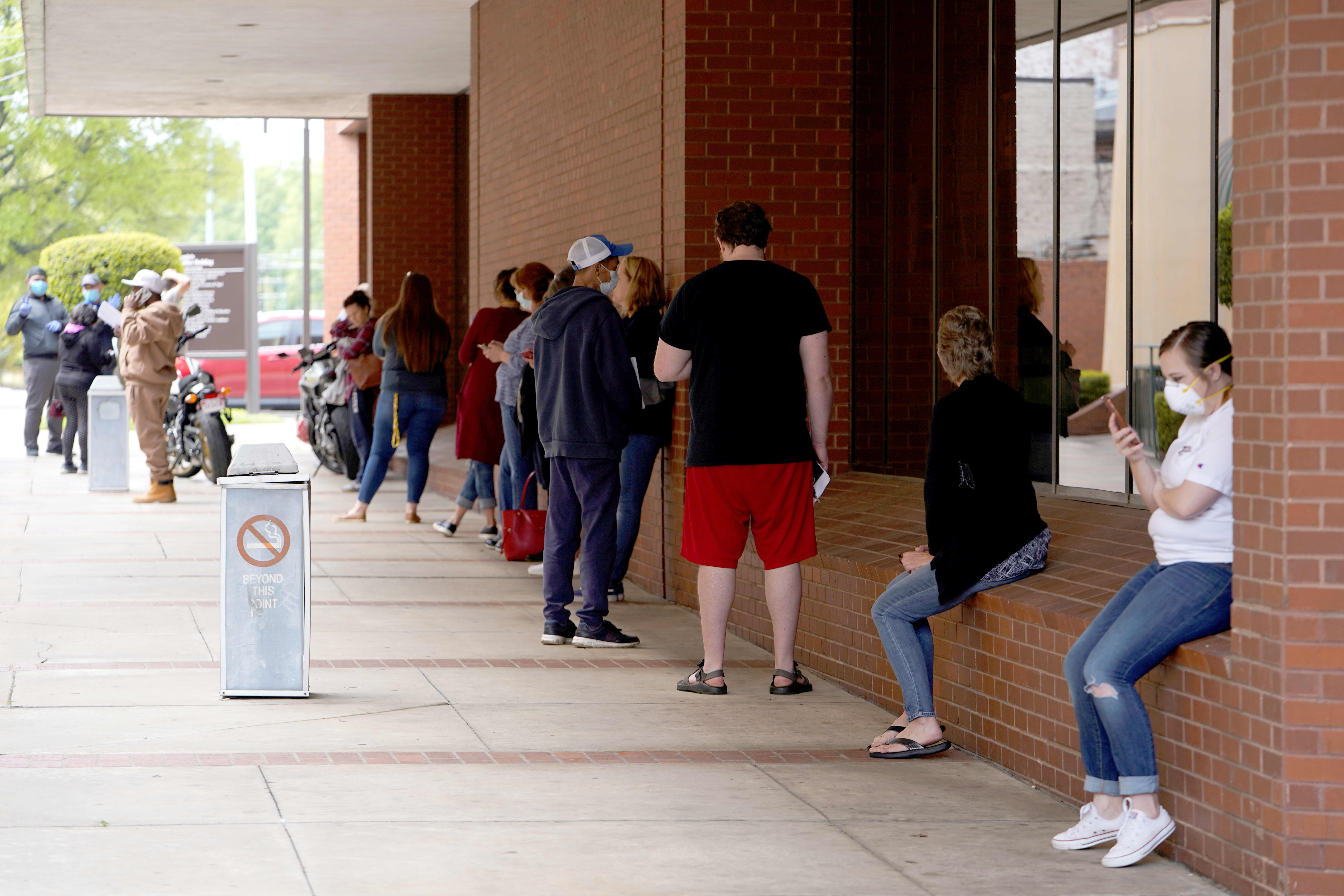
People who lost their jobs wait in line to file for unemployment following an outbreak of the coronavirus disease (COVID-19), at an Arkansas Workforce Center in Fort Smith, Arkansas, U.S. April 6, 2020.
Nick Oxford | File Photo | REUTERS
Private sector payroll data shows more than 20 million jobs were lost in April, and Friday's government report is expected to be a million more, but the most important numbers will show up in Thursday's report on how many Americans are filing new unemployment claims.
No numbers have shown the economic pain caused by coronavirus shutdowns more than the real-time filings of unemployment claims by American workers. So far, 30 million workers have filed for state benefits since late March, and 3.05 million more are expected to have filed for last week, down slightly from 3.84 million the week earlier.
But as the economy reopens in coming weeks, yet another number will become an even more important barometer: the number of continuing claims, or workers who remain on unemployment rolls and have not returned to work. That number is expected to reach nearly 20 million for last week, up from 18 million the previous week according to Refinitiv. It should ultimately start to decline, as workers go back to their jobs.
"It's a lot more timely. What will be important to pay attention to as the economy opens more and more is what does hiring look like, and what does continuing claims look like, and how quickly can we bring back those tens of millions of jobs lost," said Jon Hill, fixed income strategist at BMO. "It won't be immediate and it will also be partial. Of 25 million people, are we talking about now that 20 million go back to work? Or 24 million? This will be an important high frequency measure to watch in the next few weeks."
On Friday, the April employment report is expected to show a shocking 21.5 million jobs were lost in April and unemployment climbed to 16%, according to Dow Jones. The unprecedented one-month job losses dwarf the decline of 701,000 in March, when unemployment rose to 4.4% from a decades low 3.5%.
"Frankly, the magnitude of the losses here are so great that none of these numbers, none of these special employment indicators are going to hit the nail on the head, and get the jobless count right. It's bad. It's going to be enormously terrible," said Chris Rupkey, chief financial economist at MUFG Union Bank. "The one-month change is off the charts."
The fear is that shutdowns have continued longer than expected, and companies are making tough choices about trimming their workforces, even before they try to resume more normal activity.
For instance, MGM Resorts International, closed down in March, furloughed thousands of employees and reportedly told workers that there's now a risk the furloughs could turn into layoffs by Aug. 31. MGM is far from alone, grappling with the reopening challenges in an industry that was particularly hard hit by the abrupt shutdowns.
ADP on Wednesday said that of the unprecedented 20.2 million jobs lost in April, 16 million were in the services sector. Of those, 8.6 million worked in leisure and hospitality — at hotels, bars and restaurants. Another 3.4 million lost work in trade, transportation and utilities.
In the ADP report, 9 million workers were laid off from large companies, while 6 million were laid off from small companies and 5.3 million were with mid-size companies.
The degree to which workers return to their jobs and how they feel about job security is critical to the economy's recovery, especially since the services sector for the first time led the U.S. into recession.
The employment picture will also play a big role in whether the post-shutdown recovery looks like a V, which few now expect, a slower U-shaped recovery or even an L — a slow, sideways move.
Claims data is reported at 8:30 a.m. ET, and the government report is due Friday at 8:30 a.m. ET.
Economists say the unemployment rate may be difficult to forecast since some workers may not categorize themselves as looking for work because they expect to return to jobs. Rupkey said the number of jobless may not even show up in claims, since some workers do not apply, others don't qualify and now states may still have many workers they have not processed.
Goldman Sachs economists also pointed out the various data cannot capture the extent of the losses.
"The ADP report explicitly noted that it 'does not reflect the full impact of COVID-19 on the overall employment situation.' Reflecting this and the ADP modeling approach, we continue to believe the April ADP measure understated true job loss by several million workers," the economists noted.
"can" - Google News
May 07, 2020 at 02:48AM
https://ift.tt/2W6NSBw
This is the jobs number that will show how fast the labor market can heal - CNBC
"can" - Google News
https://ift.tt/2NE2i6G
https://ift.tt/3d3vX4n
Bagikan Berita Ini














0 Response to "This is the jobs number that will show how fast the labor market can heal - CNBC"
Post a Comment